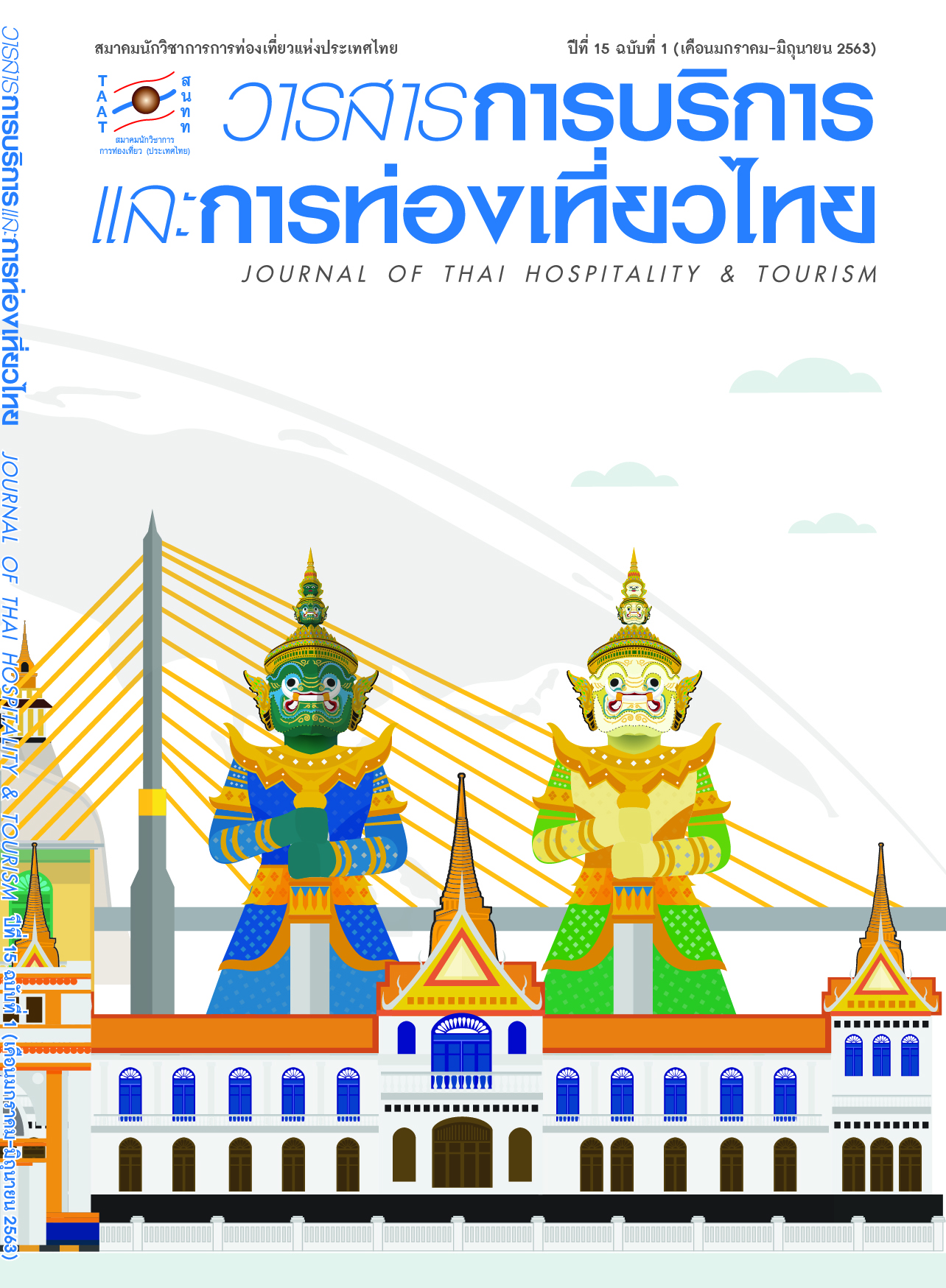สิ่งกระตุ้นและพฤติกรรมการตัดสินใจท่องเที่ยวไทยของคนจีน: กรณีศึกษาคนจีนในมณฑลเจอเจียง
Main Article Content
บทคัดย่อ
บทความนี้มีวัตถุประสงค์เพื่อตรวจสอบอิทธิพลของปัจจัยที่เป็นสิ่งกระตุ้น (ปัจจัยมหภาค และการตลาด) ที่มีต่อพฤติกรรมการตัดสินใจท่องเที่ยวไทยของคนจีน (ความเต็มใจที่จะเดินทางมาท่องเที่ยวไทยภายใน 5 ปี งบประมาณที่คาดว่าจะใช้ระหว่างท่องเที่ยวไทย และจำนวนวันที่คาดว่าจะพำนักในประเทศไทย) การศึกษาประยุกต์ใช้แนวคิด Stimulus-Response Model of Buyer Behavior ในการพัฒนาแบบจำลองความสัมพันธ์เชิงสาเหตุระหว่างปัจจัยที่สิ่งกระตุ้นและพฤติกรรมการตัดสินใจท่องเที่ยวไทย และประยุกต์ใช้ Structural Equation Model (SEM) วิเคราะห์ข้อมูลที่ได้จากการสัมภาษณ์คนจีนที่อาศัยในนครหางโจว มณฑลเจ้อเจียง จำนวน 383 ตัวอย่าง แบบจำลองประกอบด้วยตัวแปรสังเกต 19 ตัวแปร (เป็นตัวแปรต่อเนื่อง 17 ตัวแปร และตัวแปรกลุ่ม 2 ตัวแปร) และตัวแปรแฝง 9 ตัวแปร ผลการประมาณค่าความสัมพันธ์เชิงสาเหตุระหว่างปัจจัยที่สิ่งกระตุ้นและพฤติกรรมการตัดสินใจท่องเที่ยวไทยของคนจีนด้วยวิธี weighted least squares means and variance adjusted (WLSMV) พบว่า ปัจจัยที่เป็นสิ่งกระตุ้นมีอิทธิพลสูงต่อการความเต็มใจที่จะเดินทางมาท่องเที่ยวไทย และยังมีอิทธิต่อการจัดสรรงบประมาณ แต่ไม่มีอิทธิพลต่อการกำหนดจำนวนวันที่คาดว่าจะพำนัก
Article Details
References
Akarapong Untong. (2016). The Dynamics and Stability of the Elasticities of Demand for Thailand’s Long–run Tourism for Chinese Tourists’ Market. Journal of Economics and Management, 3(2), 1–16.
Akarapong Untong, Mingsarn Kaosa–ard, M., Ramos, V. & Rey–Maquieira, J. (2014). Thailand’s Long–runTourism Demand Elasticities.Tourism Economics, 20(3), 595–610.
Baloglu, S. & McCleary, K. (1999). A Model of Destination Image Formation. Annals of Tourism Research, 26(4), 868–897.
Brida, J. G. & Scuderi, R. (2013). Determinants of Tourist Expenditure: A Review of Microeconometric Models. Tourism Management Perspectives, 6(April), 28–40.
Cheung, G. W. & Rensvold, R. B. (2002). Evaluating Goodness–of–Fit Indexes for Testing Measurement Invariance. Structural Equation Modeling, 9(2), 233–255.
Chollada Mongkhonvanit, Rattanaporn Chattiwong & Thananchanok Jandang. (2013). Marketing Mix Factors Affecting Decision Making to Travel to Floating Market of Thai Youth in Bangkok. Journal of Thai Hospitality and Tourism, 8(2), 75–90.
Crompton, J. (1979). Motivations for Pleasure Vacations. Annals of Tourism Research, 6(4), 408–424.
Dann, G. (1977). Anomie, Ego–Enchantment and Tourism. Annals of Tourism Research, 4(4), 184–194.
Ewing, G. & Haider, W. (1999). Estimating What Affects Tourist Destination Choice. In Pizam, A. & Mansfield Y. (Eds.), Consumer Behavior in Travel and Tourism (pp. 35–58). New York: The Haworth Hospitality Press.
Hair, J. F., Black, W. C., Babin, B. J. & Anderson, R. E. (2010). Multivariate Data Analysis. 7th ed. New Jersey: Prentice–Hall International.
Hong, S., Kim, J. & Lee, S. (2006). The Roles of Categorization, Affective Image and Constraints on Destination Choice: An Application of the NMNL Model. Tourism Management, 27(5), 750–761.
Huybers, T. (2003). Modelling Short–Break Holiday Destination Choices. Tourism Economics, 9(4), 389–405.
Jabbari, A., Zarchi, M. K. R., Kavosi, Z., Shafaghat, T. & Keshtkaran, A. (2013). The Marketing Mix and Development of Medical Tourism in Shiraz. Medical Sciences of Bosnia and Herzegovina, 25(1), 32–36.
Kline, R. B. (2012). Assumptions of Structural Equation Modeling. In Hoyle, R. (ed.), Handbook of Structural Equation Modeling. New York: Guilford Press.
Kotler, P. & Armstrong, G. (2008). Principles of Marketing. 12th ed. New Jersey: Prentice–Hall.
La–iard Silanoi & Supawadee Sutthiruk. (2015). The Influence of Marketing Mixed Factors on Tourists’ Decision Making for Visiting the Agro–Tourism Attraction: A Case Study of Suan Sala Athit Agro–Tourism Attraction, at Ban Na San District, Surat Thani Province, Thailand. Journal of Thai Hospitality and Tourism, 10(2), 47–59.
Marrocu, E., Paci, R. & Zara, A. (2015). Micro–Economic Determinants of Tourist Expenditure: A Quantile Regression Approach. Tourism Management, 50(October), 13–30.
Middleton, T. C. V., Fyall, A., Morgan, M. & Ranchhod, A. (2009). Marketing in Travel and Tourism. 4th ed. Oxford: Elsevier.
Mingsarn Kaosa–ard, Akarapong Untong, Danaitun Pongpatcharatomtep & Natthapon Anantanasan. (2016). A Tourism Demand Chain Analysis of the Chinese Tourist Market. Research Report. Public Policy Study Institute, Chiang Mai.
Morley, C. (1994). Experimental Destination Choice Analysis. Annals of Tourism Research, 21(4), 780–791.
Muthén, L. K. & Muthén, B. O. (2012). Mplus User’s Guide. 7th ed. Los Angeles, CA.
Nouri, B. A. & Soltani, M. (2015). Evaluating the Effect of Tourism Mix on Buying Holiday Home in Cyprus. International Journal of Business Administration, 6(5), 63–74.
Ratchakorn Chotpradit, Nittaya Suriyapan & Pattrawadee Makmee. (2015). A Causal Relationship Model of Service Marketing Mix’ 7Ps Effective to Business Performance of Tourists in Selecting the Hotel Ubon Rathathani in Thailand. Journal of the Association of Researchers, 20(2), 94–104.
Ryan, C. (2003). Recreational Tourism: Demand and Impacts. Clevedon: Channel View Publications.
Shafiyan, M. (2010). Factors Affecting the Choice of Tourism Destination (A Study of Italian Tourists in Iran). Quarterly Journal of Tourism and Development, 2(2), 1–23.
Tabachnick, B. G. & Fidell, L. S. (2012). Using Multivariate Statistics. 6th ed. New York: Pearson.
UNWTO. (2014). Chinese Outbound Travel to the Middle East and North Africa. Madrid, Spain.
Uysal, M. & Jurowski, C. (1994). Testing the Push and Pull Factors. Annals of Tourism Research, 21(4), 844–846.
Uysal, M., Li, X. & Sirakaya–Turk, E. (2008). Push–Pull Dynamics in Travel Decisions. In Oh, H. (Ed.), Handbook of Hospitality Marketing Management (pp. 412–439). Butterworth–Heinemann.
Yoon, Y. & Uysal, M. (2005). An Examination of the Effects of Motivation and Satisfaction on Destination Loyalty: A Structural Model. Tourism Management, 26(1), 45–56.

